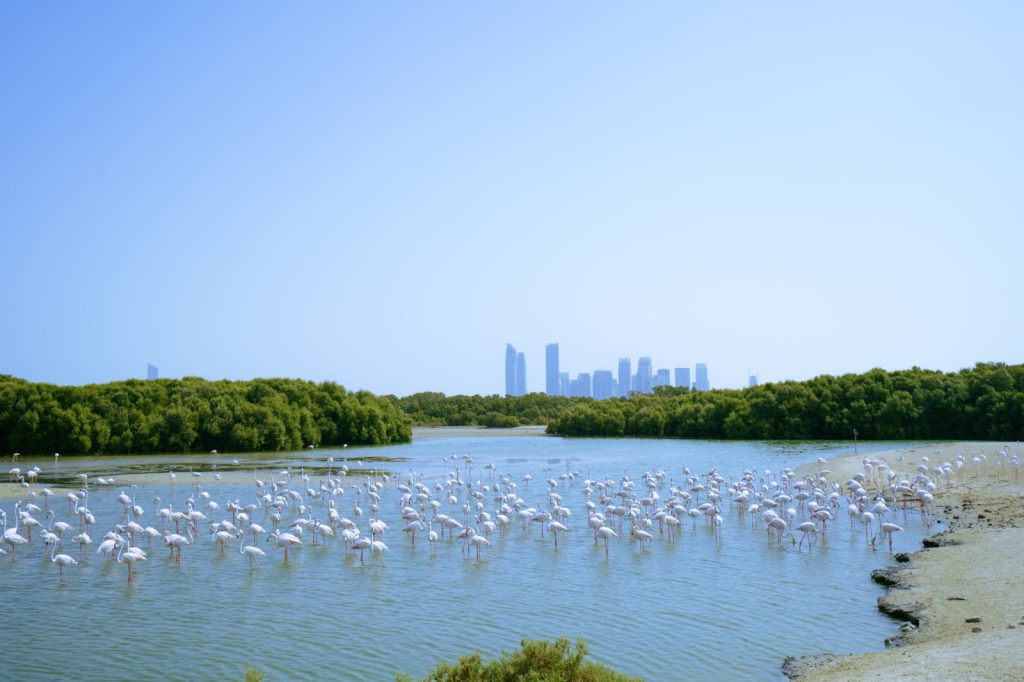Have you ever paused to notice a heron glide just above the waterline as skyscrapers rise behind it? This is not a postcard or fantasy—it happens daily in Dubai’s wetlands and coastal edges. While the city is known for architecture and opulence, its natural biodiversity remains one of the region’s best-kept secrets. Birdwatching is not just a hobby here; it’s a meditative, accessible, and seasonally thrilling practice. We can trace its cultural echoes through the region’s old pearl diving songs and maritime rhythms. Today, birdwatching blends tradition and science as local groups and expats explore the UAE’s skies. From winter migration events to casual dawn walks, the experience can fit both newcomers and serious ornithologists.
Ras Al Khor Wildlife Sanctuary is the most accessible place to start your birdwatching journey
This reserve sits at the tail of Dubai Creek, surrounded by the growing industrial landscape of the city. And yet, as soon as you step into the viewing areas, city noise fades behind a curtain of stillness. Ras Al Khor is managed to balance human access and ecological protection, with designated hides placed at strategic spots. The most iconic residents are the flamingos, which gather in hundreds during winter months. Their pink feathers brighten the shallow saltwater and create an almost surreal scene. But there’s more than flamingos—waders, herons, sandpipers, and even ospreys can be spotted depending on the season. Admission is free, and facilities are minimal but sufficient, making it ideal for first-time visitors or photographers.
The best months for birdwatching in Dubai are between November and March
Dubai’s desert heat affects not only humans but also bird movement and visibility. During summer, the air shimmers with heat and most migratory species have left. Between November and March, the temperature drops, and bird activity increases dramatically. Winter is the peak season for migratory birds that travel from Central Asia, Europe, and Africa. Wetlands fill with life, and even urban parks see more bird movement. If you’re lucky, you may spot a steppe eagle circling high or a hoopoe fluttering across a grassy patch. Early morning and sunset are the most active periods, both for light and behavior. Pack water, dress in light layers, and bring binoculars with at least 8x zoom.
Al Qudra Lakes offer a desert contrast with rich bird diversity hidden in plain sight
Al Qudra isn’t a natural wetland, but it mimics one with remarkable success. These man-made lakes are part of Dubai’s conservation and sustainability projects under the Al Marmoom Desert Conservation Reserve. The area draws both migratory and resident birds year-round. You’ll likely encounter Egyptian geese, black-winged stilts, greater spotted eagles, and even flamingos if timing aligns. The setting combines desert openness with pockets of shaded paths, which makes it ideal for walking and resting. There are no fences or gates—entry is open but visitors are expected to respect the environment. No loud music, no feeding birds, and no littering. Mornings here can feel like a quiet escape from the city’s intensity.
Jebel Ali Wetland Sanctuary is lesser known but critical for migratory waterbirds
This coastal wetland lies southwest of Dubai and remains off the radar for many casual birders. Unlike Ras Al Khor, Jebel Ali is not yet heavily developed for tourism, which adds to its appeal. It consists of mangroves, mudflats, and coastal lagoons that form a unique micro-ecosystem. It’s part of the Ramsar Convention and protected under UAE environmental regulations. You’ll find bird species here that you won’t see elsewhere—Sykes’s warbler, crab-plover, and sometimes even a booted eagle. Access is limited, and visitors usually come as part of organized eco-trips or guided photography outings. For more serious birdwatchers, this is a rewarding stop with plenty of surprises.
Mushrif Park is a surprising urban spot where owls and sunbirds coexist with joggers and picnickers
Located inland and surrounded by neighborhoods, Mushrif Park might seem an unlikely birding destination. But this large, shaded area contains acacia groves and walking trails that attract a specific type of avian population. The most iconic sighting here is the Arabian spotted owl, typically active at dusk. During the day, you’ll see purple sunbirds darting among flowers and bee-eaters taking turns on aerial dives. Since it’s a family-friendly park, timing your visit matters. Early morning or late afternoon is best to avoid crowds. The entry fee is minimal, and facilities include restrooms, shaded benches, and picnic zones. It’s a good place to teach children about birdwatching or to relax with a camera.
Dubai Desert Conservation Reserve offers sightings of raptors in open skies and endless sandscapes
This reserve is not a wetland or forest, but its avian life is surprisingly diverse. Located inland toward the eastern boundary of Dubai, the Dubai Desert Conservation Reserve covers over 200 square kilometers. It is one of the largest protected areas in the UAE. Raptors like kestrels, short-toed eagles, and desert larks are often seen gliding above the dunes. Arabian babblers and wheatears nest near desert shrubs and hide beneath small acacia trees. The best way to visit is via organized nature drives, often booked through certified operators. Binoculars are essential here, as birds can perch far out in the open. Early mornings bring cool winds and clearer sightings. Rangers are trained to share regional knowledge and safety tips. This isn’t just a wildlife spot—it’s a cultural landscape with deep roots in Bedouin tradition.

The mangroves of Ajman and Umm Al Quwain provide sanctuary to kingfishers, herons, and winter migrants
While not in Dubai city proper, these northern coastal wetlands are close enough for a morning escape. The drive to Ajman Creek or Umm Al Quwain’s mangroves takes under an hour from central Dubai. What you’ll find there is peace. Kayaking tours glide silently past herons perched in the branches. Collared kingfishers flash brilliant turquoise as they dart from tree to water. Spoonbills, cormorants, and marsh harriers also frequent these areas, especially between October and March. These mangroves are not manicured parks—they are living, breathing systems. Some are protected, while others are open to respectful recreation. Birdwatchers are encouraged to carry trash bags, respect nesting grounds, and avoid playing loud music. If you stay patient and quiet, the birds reward you.
Sharjah’s Wasit Wetland Centre is a model of conservation success in the Arabian Peninsula
This reserve lies just beyond the Dubai-Sharjah border and is worth the short drive. Wasit was once a damaged wasteland, used as a dumping site. Through extensive rehabilitation, it has become a sanctuary for over 200 bird species. It features freshwater lakes, reed beds, and coastal sand dunes. It’s also one of the most visitor-friendly reserves, offering shaded walking paths and an indoor observation hall. Glossy ibis, purple heron, moorhen, and Indian roller are commonly seen. Wasit also serves as a breeding site for many species, monitored by trained conservation staff. Schools and families visit regularly, but it’s also peaceful for solo birders. It’s a story of revival—how a destroyed area can turn into an oasis with care.
Tips for beginners who want to start birdwatching near Dubai
You don’t need expensive gear to begin birdwatching. A basic binocular and local bird guide are enough. Focus more on listening than looking in the beginning. Bird calls tell you who’s nearby. Dress in muted colors and walk slowly. Birds are easily startled by sudden movement. Avoid strong perfumes, which can carry over long distances. Choose early mornings or late afternoons for better light and cooler weather. Join local birding groups to learn from others. Many expats and Emiratis share sightings on WhatsApp or Facebook groups. Tracking migrations adds excitement to the season. Remember: birdwatching is not about collecting photos, but about observing life respectfully.
Understanding the legal and environmental ethics of birdwatching in the UAE
While birdwatching is free and open in many areas, it’s important to know the legal boundaries. Disturbing nests, entering restricted reserves without permits, or using playback sounds are prohibited. These actions can disrupt breeding cycles and attract predators. Feeding birds is also discouraged, especially in wetlands. It alters their behavior and damages their diet. Using drones near bird colonies is strictly illegal in the UAE. Authorities impose fines for flying drones near protected habitats. Ethical birders also avoid trampling vegetation and always leave no trace. If you’re unsure, ask a local guide or check signage at the site. The more informed we are, the better we protect what we admire.
Seasonal highlights and rare sightings that make Dubai’s skies worth watching all year round
Birding in Dubai changes with the seasons. In winter, migratory birds arrive in the thousands. Flamingos, stints, gulls, and larks create colorful scenes at sunrise. Spring brings passage migrants—birds stopping briefly before heading north. Warblers, bee-eaters, and shrikes flash through local parks and desert edges. Summer sees fewer birds, but those who stay are tough survivors. Hoopoes and bulbuls keep singing, even when shade disappears. Autumn brings surprises: rare visitors blown off course, or early arrivals from Asia. Rare sightings have included white-throated kingfishers, greater flamingos, and even pelicans. These moments build a sense of discovery, even after years of birding. You never really know what you’ll find.


 then "Add to Home Screen"
then "Add to Home Screen"